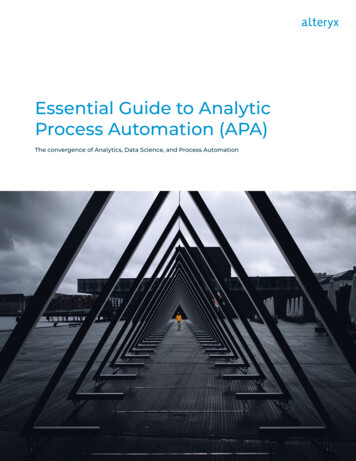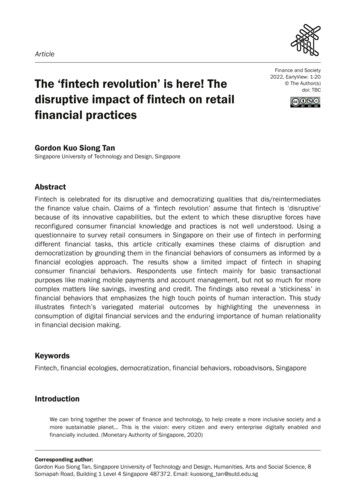
Transcription
Calhoun: The NPS Institutional ArchiveDSpace RepositoryTheses and Dissertations1. Thesis and Dissertation Collection, all items2017-12How the democratization of technologyenhances intelligence-led policing and servesthe communityCanaday, JohannaMonterey, California: Naval Postgraduate Schoolhttp://hdl.handle.net/10945/56879Copyright is reserved by the copyright owner.Downloaded from NPS Archive: Calhoun
NAVALPOSTGRADUATESCHOOLMONTEREY, CALIFORNIATHESISHOW THE DEMOCRATIZATION OF TECHNOLOGYENHANCES INTELLIGENCE-LED POLICING ANDSERVES THE COMMUNITYbyJohanna CanadayDecember 2017Thesis Co-Advisors:Carolyn HalladayKathleen KiernanApproved for public release. Distribution is unlimited.
THIS PAGE INTENTIONALLY LEFT BLANK
Form Approved OMBNo. 0704–0188REPORT DOCUMENTATION PAGEPublic reporting burden for this collection of information is estimated to average 1 hour per response, including the time for reviewinginstruction, searching existing data sources, gathering and maintaining the data needed, and completing and reviewing the collectionof information. Send comments regarding this burden estimate or any other aspect of this collection of information, includingsuggestions for reducing this burden, to Washington headquarters Services, Directorate for Information Operations and Reports, 1215Jefferson Davis Highway, Suite 1204, Arlington, VA 22202-4302, and to the Office of Management and Budget, PaperworkReduction Project (0704-0188) Washington, DC 20503.1. AGENCY USE ONLY2. REPORT DATE3. REPORT TYPE AND DATES COVEREDDecember 2017Master’s thesis(Leave blank)4. TITLE AND SUBTITLE5. FUNDING NUMBERSHOW THE DEMOCRATIZATION OF TECHNOLOGY ENHANCESINTELLIGENCE-LED POLICING AND SERVES THE COMMUNITY6. AUTHOR(S) Johanna Canaday7. PERFORMING ORGANIZATION NAME(S) AND ADDRESS(ES)Naval Postgraduate SchoolMonterey, CA 93943-50009. SPONSORING /MONITORING AGENCY NAME(S) ANDADDRESS(ES)N/A8. PERFORMINGORGANIZATION REPORTNUMBER10. SPONSORING /MONITORING AGENCYREPORT NUMBER11. SUPPLEMENTARY NOTES The views expressed in this thesis are those of the author and do not reflect theofficial policy or position of the Department of Defense or the U.S. Government. IRB number N/A .12a. DISTRIBUTION / AVAILABILITY STATEMENTApproved for public release. Distribution is unlimited.12b. DISTRIBUTION CODE13. ABSTRACT (maximum 200 words)This thesis examines how the democratization of technology can enhance intelligence-led policing andserve the community. The research compares the models of community policing and intelligence-ledpolicing and considers how the leveraging of social media platforms and personal surveillance camerascan improve police intelligence collection and enhance relationships with the community. While researchsupports intelligence-led policing to be effective in crime reduction, intelligence-led policing may alsoproduce unexpected benefits when coupled with mainstream technologies serving as a bridge to the peopleliving in those communities. These technologies can create collaborative opportunities and roles ofempowerment for citizens’ personal safety, thus potentially increasing police legitimacy and fosteringmore democratic and participatory communities. By incorporating the best of community policing, such asits goals of relationship-building and improving police legitimacy, with the crime reduction capabilities ofintelligence-led policing, we might call this community-enhanced intelligence-led policing. With thiscombination of values and positive outcomes, law enforcement may achieve the desired benefits of eachmodel.14. SUBJECT TERMSintelligence-led policing, community policing, democratization of technology, surveillancecameras, CCTV, social media, community engagement, collaboration, police legitimacy15. NUMBER OFPAGES9316. PRICE CODE17. SECURITYCLASSIFICATION OFREPORTUnclassified20. LIMITATIONOF ABSTRACT18. SECURITYCLASSIFICATION OF THISPAGEUnclassifiedNSN 7540–01-280-550019. SECURITYCLASSIFICATION OFABSTRACTUnclassifiedUUStandard Form 298 (Rev. 2–89)Prescribed by ANSI Std. 239–18i
THIS PAGE INTENTIONALLY LEFT BLANKii
Approved for public release. Distribution is unlimited.HOW THE DEMOCRATIZATION OF TECHNOLOGY ENHANCESINTELLIGENCE-LED POLICING AND SERVES THE COMMUNITYJohanna CanadayCriminal Intelligence and Analysis Manager, Fremont Police Department,Fremont, CaliforniaB.A., Saint Mary’s College of California, 1994Submitted in partial fulfillment of therequirements for the degree ofMASTER OF ARTS IN SECURITY STUDIES(HOMELAND SECURITY AND DEFENSE)from theNAVAL POSTGRADUATE SCHOOLDecember 2017Approved by:Carolyn Halladay, Ph.D.Thesis Co-AdvisorKathleen Kiernan, Ph.D.Thesis Co-AdvisorErik Dahl, Ph.D.Associate Chair for InstructionDepartment of National Security Affairsiii
THIS PAGE INTENTIONALLY LEFT BLANKiv
ABSTRACTThis thesis examines how the democratization of technology can enhanceintelligence-led policing and serve the community. The research compares the models ofcommunity policing and intelligence-led policing and considers how the leveraging ofsocial media platforms and personal surveillance cameras can improve police intelligencecollection and enhance relationships with the community. While research supportsintelligence-led policing to be effective in crime reduction, intelligence-led policing mayalso produce unexpected benefits when coupled with mainstream technologies serving asa bridge to the people living in those communities. These technologies can createcollaborative opportunities and roles of empowerment for citizens’ personal safety, thuspotentially increasing police legitimacy and fostering more democratic and participatorycommunities. By incorporating the best of community policing, such as its goals ofrelationship-building and improving police legitimacy, with the crime reductioncapabilities of intelligence-led policing, we might call this community-enhancedintelligence-led policing. With this combination of values and positive outcomes, lawenforcement may achieve the desired benefits of each model.v
THIS PAGE INTENTIONALLY LEFT BLANKvi
TABLE OF CONTENTSI.INTRODUCTION.1A.RESEARCH QUESTION .2B.KEY CONCEPTS .21.Citizen Engagement .32.Technology in the Community .43.Democratization of Technology .64.Police Legitimacy .7C.RESEARCH DESIGN .81.Selection .92.Data Sources .93.Type and Mode of Analysis .94.Audience .10D.CHAPTER OUTLINE .10II.COMMUNITY POLICING VERSUS INTELLIGENCE-LEDPOLICING .13A.COMMUNITY POLICING .13B.INTELLIGENCE-LED POLICING .21C.THE INTERSECTION OF MODELS.26D.CONCLUSION .29III.TECHNOLOGY .31A.SURVEILLANCE CAMERAS .33B.SOCIAL MEDIA .43C.CONCLUSION .49IV.ANALYSIS AND CONCLUSIONS .51A.THE POLICING MODELS.51B.SURVEILLANCE CAMERAS AND SOCIAL MEDIAPLATFORMS .54C.DEMOCRATIC COMMUNITIES .57D.POLICE LEGITIMACY.59LIST OF REFERENCES .65INITIAL DISTRIBUTION LIST .77vii
THIS PAGE INTENTIONALLY LEFT BLANKviii
LIST OF ACRONYMS AND ABBREVIATIONSALPRautomated license plate readerCCTVclosed circuit televisionGISgeographic information systemsGPSGlobal Positioning SystemIACPInternational Association of Chiefs of PoliceUCRuniform crime reportingix
THIS PAGE INTENTIONALLY LEFT BLANKx
EXECUTIVE SUMMARYThe relationship between the community and the police can be tenuous at times.Due to various tensions and conflicts from decades ago to now, police departmentsstruggle to improve community relations. Police seek to create and enhance programs tobuild relationships, engage residents, and increase police legitimacy, often throughvarious community policing programs. However, intelligence-led policing is also capableof promoting and achieving these objectives through data-rich analysis and the useof criminal intelligence. The objective of this exploratory thesis is to consider howthe democratization of technology enhances intelligence-led policing and serves thecommunity. This thesis seeks to determine how the positive outcomes and benefitsthat today’s widespread use of technology, used in coordination with the focusof intelligence-led policing, may contribute to stronger, safer, and more satisfiedcommunities.Most intelligence-led policing literature describes the use of certain technologies,but their focus is on internal processes and operations. Virtually none take intoconsideration their interaction or engagement with the public. Therefore, in place of aliterature review, key concepts of this paper explain the models of community policingand intelligence-led policing, technology in the community, the democratization oftechnology, and police legitimacy. Later chapters demonstrate how these concepts areintertwined and may benefit both law enforcement and the community. Research alsoconsisted of a review of many police departments’ use of surveillance cameras and socialmedia, particularly if formalized programs existed within the community.When data is used in a focused approach as a driving force in intelligence-ledpolicing, it can be an innovative instrument of collaboration between the two groups.Residents are playing a more active role in securing their own safety through technologyand opportunities to do so are vastly increasing thanks to the democratization oftechnology. Researching intelligence-led policing, particularly through a framework ofpopular technologies and community participation, revealed some unforeseen and veryimportant benefits. I believe intelligence-led policing has the unexpected potential toxi
create meaningful and collaborative relationships with the community, foster moredemocratic communities, and most surprisingly, enhance police legitimacy.Technology has transformed law enforcement. Social media platforms and datacaptured by private surveillance systems have become and continue to be integral topolice investigative practices and the analysis of criminal intelligence. When used incollaboration with the community, there is potential to transform relationships betweenthe police and the community and change a disengaged citizen into an empowered citizenwith opportunities to increase their personal safety.The idea of combining the crime-reducing results of intelligence-led policing withthe legitimacy goals and community engagement of community policing was expressedmany years ago with the term “community intelligence-led policing.”1 In this paper, Irevised the term to “community-enhanced intelligence-led policing” to put emphasis onintelligence-led policing with the enhanced benefits of collaborating with the communitywhile capitalizing on popular technologies.The democratization of technology has made collaboration possible by providinga platform for residents to be heard. Widespread, affordable, and easy-to-use technologiesare connecting residents more than ever with their neighbors as well as police officersand providing opportunities for empowerment and partnership. Community-enhancedintelligence-led policing has the potential to serve communities by disrupting andreducing crime as well as empowering citizens with a voice and a new role in safety.1Martin Innes, Laurence Abbott, Trudy Lowe, and Colin Roberts, “Seeing Like a Citizen: FieldExperiments in ‘Community Intelligence-Led Policing,’” Police Practice and Research, no. 10:2 (2009):99–114.xii
ACKNOWLEDGMENTSI laugh often when I consider how much of the phrase “it took a village” applies tomy getting through this program and thesis! To say I am indebted to a few special people issuch an understatement. They will not understand the depth of my gratitude, but I will say asimple thank you here. Thank you to my Fremont Police Department family who carriedthe weight of my absence and always kept me laughing. Chief Richard Lucero, thank youfor generously providing me this unparalleled opportunity and for your continued supportthroughout. I am not sure why you chose me, but I am eternally grateful that you offeredme the chance at this amazing program. I would like to thank my friend and mentor, ShellyGreene, for giving me the gentle shove to apply for this program and especially for thenearly two decades of friendship, support, and encouragement. Dr. Carolyn Halladay, I amcompletely indebted to you for sharing your wisdom and ideas as well as your patience inhelping me to develop my own. You saw the big picture of my thesis well before I ever did.And thank you for sharing your little but precious time when I came calling. Also, I couldnever have produced this document without my writing coach, Noel Yucuis. Thank you notonly for the vast amount of time you spent reviewing my work but also for your investmentin it and understanding of it. You are so much more than a “tutor”; it is ridiculous. And toimagine I almost did not reach out to the Graduate Writing Center! The NPS staff issuperb—Russell, Heather, Craig thank you for all of your support and your incredibledevotion to us and our mission. We would be lost without you. My classmates of 1601/1602—thank you. You have left an indelible mark on me. We shared such laughter, a fewtears, and many bar tabs. We continually introduced each other to new ideas and youalways challenged me to think differently, and I am very grateful and much better for it.My mom, Diane O’Malley Canaday, thank you for always believing in me. Knowing Imake you proud is all I need. And the most important debt of all is to my husband,Frederick Gibson. Thank you for your endless support and steady encouragement. Youbelieved in me long before I believed in myself. I am so grateful to you for putting up withme during the stressful times and for always wanting to celebrate the little victories. Youmade this journey possible for me. Slainte, my dear!xiii
THIS PAGE INTENTIONALLY LEFT BLANKxiv
I.INTRODUCTIONDespite conflict between many communities and police, as demonstrated throughprotests and demands for reform, communities still rely on their police departments forpublic safety. Polling shows wide racial gaps in confidence in the police, but manyagencies across the nation are creating or bolstering programs to engage residents,strengthen community relations, and increase police legitimacy.1 Intelligence-led policingcan further these programs by being precise in which offenders to pursue and bycapitalizing on data-rich analysis to set priorities and resources. The key is technology—and not just in the hands of the police.Intelligence-led policing grew out of the post-9/11 “Homeland Security era.”2 Aspart of this “era” of expanded and deepened security policies and practices, theDepartment of Homeland Security was created and local and state police agencies werecalled upon to build domestic and international partnerships and to further informationsharing to identify threats and develop responses that would effectively secure theircommunities.3 Furthermore, in 2002, the International Association of Chiefs of Police(IACP) sponsored the Criminal Intelligence Sharing Summit, resulting in several keyrecommendations including police making better use of new and existing resources,increasing opportunities for building trust, and promoting intelligence-led policing.4Effective policing today requires the intelligence-led policing model. Practitionersand academics have demonstrated intelligence-led policing as an effective model forintegrating and analyzing data from a wide selection of sources critical to settingpriorities, making executive-level decisions, and creating the best intelligence to furtherprecise and focused policing. Criminal intelligence provides this informed focus, much1 Bruce Drake, “Divide between Blacks and Whites on Police Runs Deep,” Pew Research Center(blog), April 28, 2015, acks-whites-police/.2 Jerry H. Ratcliffe, Intelligence-Led Policing, 2nd ed. (London: Routledge, 2016), 25.3 Ratcliffe.4 Marilyn Peterson, Intelligence-Led Policing: The New Intelligence Architecture (Washington, DC:Bureau of Justice Assistance), September 2005, 3, cliffe, Intelligence-Led Policing, 2nd ed., 25.1
more so than sweeping enforcement efforts, such as New York Police Department’s past“stop and frisk” activity. These indiscriminate contacts alienated community membersand significantly threatened police legitimacy.5With intelligence-led policing’s requirement of utilizing extensive dataresources—from surveillance reports to confidential informants—this model may be seenby various members of the public as an invitation for police to violate their civil liberties.Whether this threat is real or perceived, it may still put the community at odds with itspolice department. Conversely, when data is used in a focused approach as a drivingforce in intelligence-led policing, it can be a great instrument of collaboration betweenthe two groups. Rather than merely “being policed,” residents are playing a more activerole in securing their own safety through technology. These opportunities to do so arevastly increasing, thanks to the democratization of technology.A.RESEARCH QUESTIONHow does the democratization of technology enhance intelligence-led policingand serve the community?B.KEY CONCEPTSThe literature base is relatively silent in research on intelligence-led policingdiscussing direct engagement with the community, which more conventionally isconsidered to be the domain of the community policing model. Also, most intelligenceled policing literature is inclusive of certain technologies, but few take into considerationthe interaction or engagement with the public. Furthermore, particular law enforcementagency practices, including techniques and technologies, may not be well documented inthe public realm. Finally, the majority of research on surveillance cameras pertains to theUnited Kingdom and refers to government-owned installations with a great variation offindings on the effects of crime deterrence and reduction.5 Tom R. Tyler, Jeffrey Fagan, and Amanda Geller, “Street Stops and Police Legitimacy: TeachableMoments in Young Urban Men’s Legal Socialization,” Journal of Empirical Legal Studies 11, no. 4(2014): 751–85.2
Therefore, instead of a traditional literature review, I address key concepts that arecentral to this thesis that are addressed in the following chapters.1.Citizen EngagementCitizens have long been actively engaged in keeping their communities safe.Their activity in crime prevention and participation in public safety pre-dates colonialtimes, when Native Americans kept order through public opinion as well as definedcustoms and religious sanctions.6 In the colonial era of the 1600s, “volunteerism” wasoften mandatory and took the form of “watch and ward committees,” which were formedas an early version of citizen patrols.7 Their duties consisted of maintaining street lamps,reporting fires, dealing with runaway animals, and sounding a general alarm whencriminal activity was observed.8 Constabularies were later developed and viewed as acommunal responsibility of all white male adults.9 While their role extended intocatching criminals, they tended to spend more time and attention toward the lucrativefield of tax collection.10 The role of citizens continued to evolve over the decades. Theirservice was so important that the establishment of citizen militias took form with theSecond Amendment of the U.S. Constitution and further expanded with the Militia Act of1792, which required most adult white males to bear arms and attend regular exercises.11According to historian Martin Greenberg, these volunteer militias were used primarily for“strike-breaking, riot control, and disaster relief.”12 The militia groups eventually fell into6 William T. Hagan, Indian Police and Judges Experiments in Acculturation and Control (NewHaven, CT: Yale University Press, 1966), 16.7 Martin Alan Greenberg, Citizens Defending America: From Colonial Times to the Age of Terrorism(Pittsburgh, PA: University of Pittsburgh Press, 2005), 3, 780822942641exr.pdf.8 Mark H. Moore and George L. Kelling, “To Serve and Protect: Learning from Police History,” ThePublic Interest, no. 70 (1983): 51.9 Greenberg, Citizens Defending America, 4.10 Wilbur R. Miller, ed. The Social History of Crime and Punishment in America: An Encyclopedia(Thousand Oaks, CA: SAGE Publications, 2012).11 Greenberg, Citizens Defending America, 4.12 Greenberg, 5.3
disuse, but “citizen soldiers” evolved into the modern National Guard system followingthe passing of the Militia Act of 1903.13The growing urban populations of the mid-1800s gave rise to the creation offormal police organizations, which, in turn, significantly diminished the public safety roleof the citizen.14 Amid increases in crime, social disorder, and urbanization, policingbecame too much for citizen groups to handle. The cities of New York, Boston, andPhiladelphia established police departments with a focus on combatting crime anddisorder.15 Today, some 765,000 men and women serve as officers in local, county, andstate law enforcement in the United States.16Citizen participation has evolved over a few hundred years, from securing safetyas a private communal effort to shifting this responsibility to modern law enforcementofficers. With approximately 2,000 United States police departments offering formalvolunteer programs, many opportunities exist for citizens to serve.17 New approaches topolicing also have brought new opportunities for citizen involvement. The innovation ofthe community policing model brought citizens back into the picture of activeparticipation in public safety through both formal and informal roles—for example,participation in volunteer programs or as an engaged neighbor willing to reportsuspicious activities in the neighborhood.2.Technology in the CommunityWhile citizen involvement is foundational to the community policing model,intelligence-led policing also has the potential to capitalize on the force multipliers of the13 “America’s Citizen Soldiers—A Short History of the Militia in the United States” Military HistoryNow, accessed November 7, 2017, the-united-states/.14 Encyclopedia Britannica, s.v. police—early police in the United States, accessed August 31, -police-in-the-United-States.15 Encyclopedia Britannica.16 “National Sources of Law Enforcement Employment Data,” U.S. Department of Justice, accessedSeptember 25, 2017, https://www.bjs.gov/content/pub/pdf/nsleed.pdf.17 “Volunteer Programs Enhancing Public Safety by Leveraging Resources,” Bureau of JusticeAssistance, accessed September 25, 2017, L%20Resource%20Toolkit/Volunteer%20Programs.pdf.4
community. There are thousands of additional eyes and ears beyond the officers’ that arewilling and able to engage through technologies such as social media or sharing privatevideo surveillance. So, in addition to the models’ divergent paths toward the commondesire to engage with the community, their ultimate objectives vary significantly.18Furthermore, they tend to produce different results in areas from police legitimacy toharm and crime reduction.Developing technologies over the last two hundred years has caused people tofear the weakening of the private community, disengagement from neighborhoods, andthe decline of the public community.19 While the rise of global Internet use, reachingmainstream populations in the mid-1990s, rekindled these concerns, subsequenttechnologies such as surveillance cameras are likely to be equally concerning. Access tothe Internet in many cases has supplanted the need to build relationships and seekinformation from public or community officials as it has become much easier to findinformation anonymously without having to engage at the community or national level.Nevertheless, today’s widespread availability and use of certain technologies areredefining roles for citizens to participate with law enforcement in improving the safetyof communities. The use of social-media and surveillance-camera technologies arepaving the way for police and citizen interaction that directly leads to crime reduction,the primary objective of intelligence-led policing.Despite the concerns of the Internet spoiling socialization and community, manybelieve that technologies positively impact individuals and communities. Individualschoose to engage in new ways aided by technology to communicate, share, and learn. Forexample, a 1997 experiment in Toronto, Canada, known as “Netville” provided a randomselection of a neighborhood community with a wireless Internet connection and anInternet-based communal platform.20 The objective of the study was to answer the18 Ratcliffe, Intelligence-Led Policing, 2nd ed.19 Keith Hampton and Barry Wellman, “Neighboring in Netville: How the Internet SupportsCommunity and Social Capital in a Wired Suburb,” City & Community 2, no. 4 (2003): 2.20 Hampton and Wellman.5
question of what the Internet was doing to the local community.21 The resultsdemonstrated that neighbors were not alienated nor did they withdraw from theircommunity. In fact, it was deemed that the platform assisted to “personalize firstencounters with a sense of shared interest and a sense of community.”22The findings reveal that communities that connect through social media platformsmay appear more engaged with one another, participate in looking out for each other’ssafety, and recognize themselves as being more “neighborly.”23 Shared values andinterests, coupled with today’s technologies, can fuel powerful collaborative partnerships.3.Democratization of TechnologyThe phrase “democratization of technology” refers to the rapid accessibility,affordability, and ease of use of technology for today’s consumers.24 This globalizationby-product creates opportunities for citizens to engage in improving their own personalsafety in ways that previously did not exist. For example, surveillance cameras were onceexpensive and highly technical but now are very affordable and easy to operate andmaintain. Intelligence-led policing’s focus on technology, data, and analysis leveragesthis new widespread use, particularly through the use of cameras, for the empowermentof neighborhoods and their residents to contribute information to affect policing andcrime. The relationship between parties becomes much less one-dimensional, rather moredemocratic. The multitude of technological products, from video-enabled smartphones tofront-porch surveillance cameras, creates opportunities for collaborative relationshipsbetween the police and their communities that may have been previously damaged orotherwise not have existed.Andrew Feenberg, a leading technology philosopher and researcher, argues thatexpanding technology to include alternative interests and values can be a tool of21 Hampton and Wellman, 1.22 Hampton and Wellman, 18.23 Hampton and Wellman, 25.24 Thomas L. Friedman, The Lexus and the Olive Tree (New York: Anchor Books, 2000), 38; SamirEstefan, “The Democratization of Technology,” ISACA, accessed November 5, sts/Posts/Post.aspx?ID 330.6
inclusiveness, an important participatory role for users.25 This inclusiveness fostersopportunities for citizens to interact with government. When technology is not imposedupon the people but includes them, it may diminish controversy and concerns, primarilyover privacy issues. Globalization and technological advances create opportunities forcitizens to improve their safety in ways that were previously nonexistent. Technologybecomes empowering and democratic when it provides a platform for participation,creates space for voi
NAVAL POSTGRADUATE SCHOOL MONTEREY, CALIFORNIA THESIS Approved for public release. Distribution is unlimited. HOW THE DEMOCRATIZATION OF TECHNOLOGY ENHANCES INTELLIGENCE-LED POLICING AND SERVES THE COMMUNITY by Johanna Canaday December 2017 Thesis Co-Advisors: Carolyn Halladay Kathleen Kiernan










